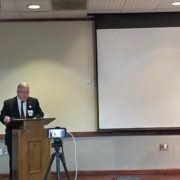TownTalk: Student Behavior Health Team Helps Students Through Trauma
Educators are continually assessing the students in their classrooms – whether it’s to make sure they’ve mastered their math facts or can accurately retell a story in their own words to show understanding.
But teachers in Vance County Schools are also being trained to assess their students’ mental health needs as well. And the district’s Student Behavior Health Team is one resource that teachers can call upon for help.
The SBHT is a collaborative effort of social workers and counselors within the school district, along with trauma conflict/dropout prevention and safety and security experts that works to connects students and their families to resources in the community.
Team members joined guest co-host Phyllis Maynard on Tuesday’s TownTalk as part of the recurring segment “Former Active Duty, Still Boots on the Ground.” Children with a parent who is currently deployed or who is a veteran of the military sometimes face additional struggles and challenges at school because of their parents’ situations, she said.
Maynard spoke with VCS Assistant Superintendent Michelle Burton, VCS coordinator for safety and security Travis Taylor, VCS lead social worker Toni Fletcher, VCS lead counselor Erica Wright and VCS dropout prevention specialist Dr. Ralphel Holloman, Sr. about how the SBHT works to support educators and the students and families across the district.
“What we’re looking at is prevention,” Wright said. Mental health struggles, including children expressing suicidal tendencies, had been on the uptick before the COVID-19 pandemic. The return to school has not been a smooth transition for all students, and it’s important for school staffs to first of all, acknowledge the issues that so many children are dealing with, she added.
This is the first year of the state’s school mental health initiative and it provides a framework through which schools can address mental health issues that students face in and outside of school, Burton said.
Some children are still scared of COVID-19, Fletcher said, which adds to the stress of returning to the classroom. “Many of our children lost family members (to COVID-19),” she said. “It hit home and they’re struggling,” she said, adding that she has seen an increase in emotional issues with children coming back into the classroom.
But there are resources available for students – and their families – in the community, and that’s where the SBHT can step in as a liaison between community partners and the families that may need their help.
“If they have challenges or questions, we are here for them,” Burton said. Sometimes a situation is resolved at the school level, but if additional support is required, outside agencies may be called in to assist.
Holloman said it’s important for students to have a “go-to” person before something happens. “We’re there to educate and build (positive) relationships,” Holloman said. Likewise, teachers are encouraged to pick up on behaviors that could be signs of trouble.
Excessive absences are the primary reason that high school students drop out, and Holloman said early intervention is crucial to keep kids in school. He said prevention, intervention and recovery are the three keys to dropout prevention. Students who have been out of school for one reason or another can transition back to the classroom through the district’s alternative school.
Spotty school attendance could be a sign that a family is experiencing homelessness, Fletcher said. “We want to promote our children being in school so they can be successful,” she said. Identifying the immediate needs of a homeless family is another way the SBHT can provide support through community resources.
Taylor, the district’s safety and security officer, said the district takes seriously the need for safety assessments – whether it’s an assessment of a school building or the safety of a student exhibiting warning signs of a mental health crisis, such as suicide.
“We do not take it lightly at all,” Taylor said. “We never want to be put in a situation where we missed something.”
CLICK PLAY!









